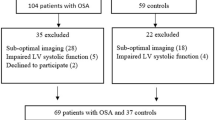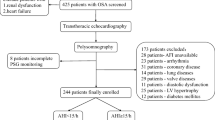Abstract
Background
Previous studies have demonstrated that patients with obstructive sleep apnea (OSA) may develop left ventricular (LV) diastolic dysfunction. We aimed to study whether OSA patients have LV regional systolic dysfunction with myocardial deformation changes, despite a normal LV ejection fraction, using real-time 3D speckle-tracking echocardiography (Rt3D-STE).
Methods
Seventy-eight patients with OSA and no comorbidities were studied. They were divided into the following three groups according to the apnea–hypopnea index (AHI): 5~15/h as group I (mild OSA, 26 cases), 15~30/h as group II (moderate OSA, 29 cases), and ≥30/h as group III (severe OSA, 23 cases). Thirty gender–age-matched normal subjects were included as controls. The parameters of LV diastolic function were acquired with traditional echocardiography. The LV myocardial deformation parameters were obtained, including the longitudinal (LS), circumferential (CS), radial (RS), and area (AS) strains, with Rt3D-STE.
Results
LV global systolic function was normal in all patients, but diastolic function was impaired in groups II and III (E/E′ was 9.6 ± 2.8 and 10.4 ± 2.5, respectively, p < 0.0001). The global LS and AS were significantly reduced in groups II and III compared with the controls and group I (LS 15.9 ± 1.4 % and 14.8 ± 1.5 % vs 18.2 ± 1.7 % and 17.8 ± 1.5 %; AS 27.4 ± 1.8 % and 24.9 ± 2.3 % vs 33.4 ± 2.2 % and 32.7 ± 2.9 %, respectively, p < 0.0001), but the global CS and RS were significantly reduced only in group III (17.3 ± 1.4 % and 43.1 ± 6.5 % vs 19.6 ± 1.6 % and 55.4 ± 4.0 %, respectively, <0.0001). The severity of OSA was significantly associated with the LV global AS value (r = −0.80, p < 0.0001), LS (r = −0.64, p < 0.0001), CS (r = −0.51, p < 0.0001), and RS (r = −0.62, p < 0.0001).
Conclusions
Patients with moderate and severe OSA tended to have both LV diastolic dysfunction and abnormalities in regional systolic function with myocardial deformation changes, in spite of the normal LV ejection fraction. Myocardial strains of the LV were negatively correlated with the AHI. Rt-3DST had important clinical significance in the early evaluation of cardiac dysfunction in OSA patients.


Similar content being viewed by others
References
Lorenzi Filho G, Genta PR, Pedrosa RP, Drager LF, Martinez D (2010) Cardiovascular consequences of obstructive sleep apnea syndrome. J Bras Pneumol 36:38–42
Hla KM, Young T, Finn LA, Peppard PE, Kinsey TJ, Ende D (2008) Electrocardiographically indicated cardiovascular disease in sleep-disordered breathing. Sleep Breath 12(3):251–258
Dursunoglu N, Dursunoglu D, Kiliç M (2005) Impact of obstructive sleep apnea on right ventricular global function: sleep apnea and myocardial performance index. Respiration 72(3):278–284
Bonow RO, Udelson JE (1992) Left ventricular diastolic dysfunction as a cause of congestive heart failure. Mechanisms and management. Ann Intern Med 117(6):502–510
Fischer M, Baessler A, Hense HW, Hengstenberg C, Muscholl M, Holmer S, Döring A, Broeckel U, Riegger G, Schunkert H (2003) Prevalence of left ventricular diastolic dysfunction in the community. Results from a Doppler echocardiographic-based survey of a population sample. Eur Heart J 24(4):320–328
Artis NJ, Oxborough DL, Williams G, Pepper CB, Tan LB (2008) Two-dimensional strain imaging: a new echocardiographic advance with research and clinical applications. Int J Cardiol 123(3):240–248
Sun JP, Niu J, Chou D, Chuang HH, Wang K, Drinko J, Borowski A, Stewart WJ, Thomas JD (2007) Alterations of regional myocardial function in a swine model of myocardial infarction assessed by echocardiographic 2-dimensional strain imaging. J Am Soc Echocardiogr 20(5):498–504
Tanaka H, Hara H, Saba S, Gorscan J 3rd (2010) Usefulness of three-dimensional speckle tracking strain to quantify dyssynchrony and the site of latest mechanical activation. Am J Cardiol 105(2):235–242
Maffessanti F, Nesser HJ, Weinert L, Steringer-Mascherbauer R, Niel J, Gorissen W, Sugeng L, Lang RM, Mor-Avi V (2009) Quantitative evaluation of regional left ventricular function using three-dimensional speckle tracking echocardiography in patients with and without heart disease. Am J Cardiol 104(12):1755–1762
Pérez de Isla L, Balcones DV, Fernández-Golfín C, Marcos-Alberca P, Almería C, Rodrigo JL, Macaya C, Zamorano J (2009) Three-dimensional-wall motion tracking: a new and faster tool for myocardial strain assessment: comparison with two-dimensional-wall motion tracking. J Am Soc Echocardiogr 22(4):325–330
Thebault C, Donal E, Bernard A, Moreau O, Schnell F, Mabo P, Leclercq C (2011) Real-time three-dimensional speckle tracking echocardiography: a novel technique to quantify global left ventricular mechanical dyssynchrony. Eur J Echocardiogr 12(1):26–32
Ammar KA, Paterick TE, Khandheria BK, Jan MF, Kramer C, Umland MM, Tercius AJ, Baratta L, Tajik AJ (2012) Myocardial mechanics: understanding and applying three-dimensional speckle tracking echocardiography in clinical practice. Echocardiography 29(7):861–872
Badano LP, Cucchini U, Muraru D, Al Nono O, Sarais C, Iliceto S (2013) Use of three-dimensional speckle tracking to assess left ventricular myocardial mechanics: inter-vendor consistency and reproducibility of strain measurements. Eur Heart J Cardiovasc Imaging 14(3):285–293
Jasaityte R, Heyde B, D'Hooge J (2013) Current state of three-dimensional myocardial strain estimation using echocardiography. J Am Soc Echocardiogr 26(1):15–28
Chen H, De Marco T, Kobashigawa EA, Katz PP, Chang VW, Blanc PD (2011) Comparison of cardiac and pulmonary-specific quality-of-life measures in pulmonary. Eur Respir J 383(3):608–16
Fung JW, Li TS, Choy DK, Yip GW, Ko FW, Sanderson JE, Hui DS (2002) Severe obstructive sleep apnea is associated with left ventricular diastolic dysfunction. Chest 121(2):422–429
Valdivia-Arenas MA, Powers M, Khayat RN (2009) Sleep-disordered breathing in patients with decompensated heart failure. Heart Fail Rev 14(3):183–193
Noda A, Miyata S, Yasuda Y (2013) Therapeutic strategies for sleep apnea in hypertension and heart failure. Pulm Med
Somers VK, White DP, Amin R, Abraham WT, Costa F, Culebras A, Daniels S, Floras JS, Hunt CE, Olson LJ, Pickering TG, Russell R, Woo M, Young T (2008) Sleep apnea and cardiovascular disease. J Am Coll Cardiol 52(8):686–717
Virolainen J, Ventila M, Turto H, Kupari M (1995) Effect of negative intrathoracic pressure on left ventricular pressure dynamics and relaxation. J Appl Physiol 79(2):455–460
Hall MJ, Ando SI, Floras JS, Bradley TD (1998) Magnitude and time course of hemodynamic responses to Mueller maneuvers in patients with congestive heart failure. J Appl Physiol 85(40):1476–1484
Robotham JL, Rabson J, Permutt S, Bromberger-Barnea B (1979) Left ventricular hemodynamics during respiration. J Appl Physiol 47(6):1295–1303
Scharf SM, Graver LM, Balaban K (1992) Cardiovascular effects of periodic occlusions of the upper airways in dogs. Am Rev Respir Dis 146(2):321–329
Brinker JA, Weiss JL, Lappe DL, Rabson JL, Summer WR, Permutt S, Weisfeldt ML (1980) Leftward septal displacement during right ventricular loading in man. Circulation 61(3):626–633
Summer WR, Permutt S, Sagawa K, Shoukas AA, Bromberger-Barnea B (1979) Effects of spontaneous respiration on canine left ventricular function. Circ Res 45(6):719–728
Oliveira W, Campos O, Bezerra Lira-Filho E, Cintra FD, Vieira M, Ponchirolli A, de Paola A, Tufik S, Poyares D (2008) Left atrial volume and function in patients with obstructive sleep apnea assessed by real-time three-dimensional echocardiography. J Am Soc Echocardiogr 21(12):1355–61
Oliveira W, Campos O, Cintra F, Matos L, Vieira ML, Rollim B, Fujita L, Tufik S, Poyares D (2009) Impact of continuous positive airway pressure treatment on left atrial volume and function in patients with obstructive sleep apnoea by real-time three-dimensional echocardiography. Heart 95(22):1872–8
Jean-Louis G, Zizi F, Clark LT, Brown CD, McFarlane SI (2008) Obstructive sleep apnea and cardiovascular disease: role of the metabolic syndrome and Its components. J Clin Sleep Med 4(3):261–272
Jean-Louis G, Zizi F, Brown D, Ogedegbe G, Borer J, McFarlane S (2009) Obstructive sleep apnea and cardiovascular disease: evidence and underlying mechanisms. Minerva Pneumol 48(4):277–293
Feng J, Zhang D, Chen B (2012) Endothelial mechanisms of endothelial dysfunction in patients with obstructive sleep apnea. Sleep Breath 16(2):283–294
Atkeson A, Jelic S (2008) Mechanisms of endothelial dysfunction in obstructive sleep apnea. Vasc Health Risk Manag 4(6):1327–1335
Perrelli MG, Pagliaro P, Penna C (2011) Ischemia/reperfusion injury and cardioprotective mechanisms: role of mitochondria and reactive oxygen species. World J Cardiol 3(6):186–200
Dematteis M, Julien C, Guillermet C, Sturm N, Lantuejoul S, Mallaret M, Lévy P, Gozal E (2008) Intermittent hypoxia induces early functional cadiovascular remodeling in mice. Am J Respir Care Med 177(2):227–35
Matsumoto C, Hayashi T, Kitada K, Yamashita C, Miyamura M, Mori T, Ukimura A, Ohkita M, Jin D, Takai S, Miyazaki M, Okada Y, Kitaura Y, Matsumura Y (2009) Chymase plays an important role in left ventricular remodeling induced by intermittent hypoxia in mice. Hypertension 54(1):164–71
Zhou S, Yin X, Zheng Y, Miao X, Feng W, Cai J, Cai L (2014) Metallothionein prevents intermittent hypoxia-induced cardiac endoplasmic reticulum stress and cell death likely via activation of Akt signaling pathway in mice. Toxicol Left 227(2):113–23
Feigenbaum H, Mastouri R, Sawada S (2012) A practical approach to using strain echocardiography to evaluate the left ventricle. Circ J 76(7):1550–1555
Saito K, Okura H, Watanabe N, Hayashida A, Obase K, Imai K, Maehama T, Kawamoto T, Neishi Y, Yoshida K (2009) Comprehensive evaluation of left ventricular strain using speckle tracking echocardiography in normal adults: comparison of three-dimensional and two-dimensional approaches. J Am Soc Echocardiogr 22(9):1025–1030
Torrent-Guasp F, Ballester M, Buekberg GD, Carreras F, Flotats A, Carrió I, Maehama T, Kawamoto T, Neishi Y, Yoshida K (2011) Spatial orientation of the ventricular muscle band: physiologic contribution and surgical implications. J Thorac Cardiovasc Surg 122(9):389–382
Urbano-Moral JA, Arias-Godinez JA, Ahmad R, Malik R, Kiernan MS, DeNofrio D, Pandian NG, Patel AR (2013) Evaluation of myocardial mechanics with three-dimensional speckle tracking echocardiography in heart transplant recipients: comparison with two-dimensional speckle tracking and relationship with clinical variables. Eur Heart J-Cardiovasc Imaging 14(12):1167–1173
Wen H, Liang Z, Zhao Y, Yang K (2011) Feasibility of detecting early left ventricular systolic dysfunction using global area strain: a novel index derived from three-dimensional speckle tracking echocardiography. Eur J Echocardiogr 12(12):910–916
Sun JP, Lee AP, Wu C, Lam YY, Hung MJ, Chen L, Hu Z, Fang F, Yang XS, Merlino JD, Yu CM (2013) Quantification of left ventricular regional myocardial function using two-dimensional speckle tracking echocardiography in healthy volunteers—a multi-center study. Int J Cardiol 167(2):495–501
Conflict of interest
No potential conflict of interest relevant to this article was reported.
Author information
Authors and Affiliations
Corresponding author
Rights and permissions
About this article
Cite this article
Wang, D., Ma, G.S., Wang, X.Y. et al. Left ventricular subclinical dysfunction associated with myocardial deformation changes in obstructive sleep apnea patients estimated by real-time 3D speckle-tracking echocardiography. Sleep Breath 20, 135–144 (2016). https://doi.org/10.1007/s11325-015-1197-8
Received:
Revised:
Accepted:
Published:
Issue Date:
DOI: https://doi.org/10.1007/s11325-015-1197-8




